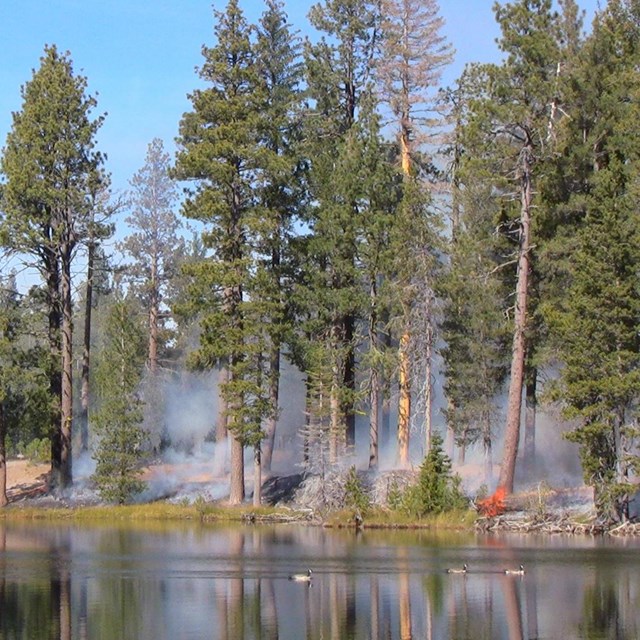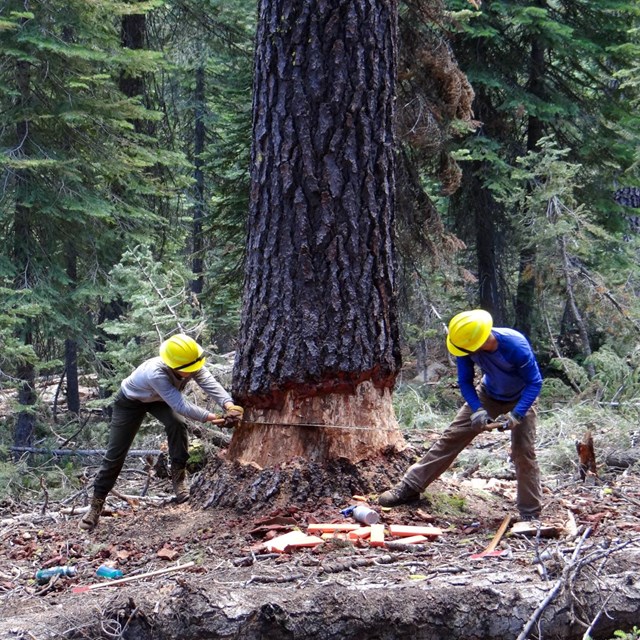
NPS photo Wildland fire has long been recognized as one of the most significant natural processes operating within and shaping the northern Sierra Nevada and southern Cascade Mountain ecosystems. Virtually all vegetation communities show evidence of fire dependence or tolerance. Many forest types in the park have been shaped by frequent fire return intervals (ranging from 5-16 years) as evidenced by park research. At the same time, wildland fire has the potential to threaten human lives and property. Fire management requires balancing the risks and benefits of fire in our wildlands. Lassen Volcanic's Fire Management Program addresses the specific priorities, challenges, and approaches that are most likely to be effective in the park. Wildland Fire Management Goals (Abbreviated)
Fire Management StrategiesThe park uses five fire management strategies to acheive resource and fire management goals. The specific program of action for the next 10 years is outlined in the park's Fire Management Plan (below). Fire management staff assesses each lightning caused fire in the Wilderness for the potential to be managed for resource benefit. Natural fires that occur within predetermined geographic areas may be managed under strict parameters to achieve specific resource management objectives. Learn more about the contemporary history of fire in the park, including occurences of fire within designated Wilderness. Wildland fire suppression is an appropriate management response to some wildland fires which threaten life, property, and critical resources. All suppression actions are implemented with firefighter safety as the highest consideration. Suppression activities seek to minimize loss of resource values, economic spending, and the use of firefighters. Learn more about the effects of suppression in the park's early fire history (approximately 1904-1980s). Manual treatment is the use of hand tools or hand operated power tools to reduce hazardous accumulations of wildland fuels and to create defensible space near structures and along prescribed fire boundaries. Learn about the use of manual fuel treatments in the Warner Valley and Juniper Lake areas of the park. Mechanical treatments include the use of larger mechanized equipment such as front end loaders, tub grinders, and other large equipment in order to move and process larger material. Mechanical treatments are used only in developed areas to remove larger diseased trees which pose a hazard to the public. Learn about the use of mechanized treatments followed by prescribed fire in the Manzanita Lake and Lost Creek areas. Prescribed fires are ignited by management to achieve specific resource objectives. In some forest types it is necessary to return and retreat these areas with prescribed fire in order to maintain them. These operations are not mutually exclusive and usually all prescribed fire operations contain a mix of initial treatment and maintenance treatment. Prescribed fires must be described in a prescribed fire burn plan. The plan will contain a prescription defining goals, objectives, and treatment methods employed to achieve the objectives. The park employs methods to monitor areas before and after treatment to insure that fire management operations are meeting resource management objectives. Fire Management PlanCurrent Plan: Lassen Volcanic National Park (LAVO) Fire Management Plan (PDF, 3.3MB) The Fire Management Plan (FMP) defines the program of wildland fire management for Lassen Volcanic National Park. The plan describes objectives and tasks covering a 10-year timeframe for using five fire management strategies to achieve desired natural and cultural resource conditions while also protecting park resources and adjacent lands and values at risk from the negative impacts of fire. Appendix A - References (90 KB, PDF) Current Fire Management Projects
More Information
|
Last updated: September 1, 2024





